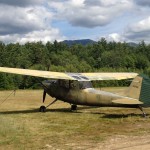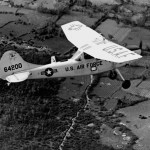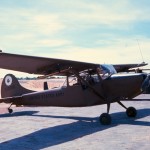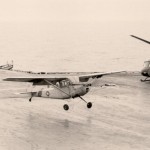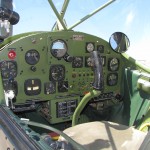
It was an airplane for a different time. It was an airplane before there were unmanned aerial vehicles. Back when, if you wanted to know what was ahead or what was behind the lines, you had to put a gutsy pilot in an actual airplane and have him fly out to see for himself. This was the plane those gutsy pilots used from Korea to Vietnam.
The website, Talking Proud, sums it up nicely:
There are countless ways to come to grips with the almost indescribable courage and bravery of our armed forces in the Vietnam-Laos Wars. Understanding the men who flew the O-1 “Bird Dog” Forward Air Controller is one. The valor of those Americans who fought these wars creates an inexplicable reverence in our hearts. Much has been capably written about these FACs and their machines. More must be written, more must be read, more must be understood. These were “chariots with wings,” the toughest little dogs in the fight, the eyes in the sky, a warbug, a centerpiece of the hunter-killer team that heaped lead upon the enemy’s head.
The U.S. Army developed the O-1 from the successful Cessna 170. It was originally called the L-19 until the naming convention changed. The O-1 was built for Forward Air Control. That is, ensuring that attackers hit their targets and avoid friendlies. They could provide bearings for artillery or give forces on the ground an indication of what they were up against. During Vietnam, they would give air strike packages of F-4’s and other jets proper directions to ensure they attacked the enemy and didn’t drop their bombs on an American platoon. It is a gritty job, neither glamorous nor flashy.
The O-1 sat two people, a pilot in the front and an observer in the rear. The plane was remarkably simple and inexpensive, which is one reason why it remains popular with hobbyists. Despite the newer, faster O-2 “Skymaster” that came about in the mid-1960s, the Viet Cong still feared the “Bird Dog” more because it was whisper quiet and provided a better field of view. The observer could see behind him, which could not be done with newer observation planes. And when an O-1 was finally spotted, a VC commander knew a barrage or airstrike was not far behind.
The O-1 was widely used by the friendly South Vietnamese Air Force pilots and by clandestine forces during the war.
In a paper for the Air War College in 1979, Major Donald K. Schneider summed up the life of an O-1 pilot:
The light craft was often buffeted by gusty winds and turbulence, and the cockpit was noisy, cramped, and uncomfortable. Without the benefit of air conditioning, and surrounded by his survival kit, M-16 rifle, sidearm, knife, and maps, the FAC sweltered in the tropical heat and humidity. The Bird Dog had no offensive firepower, and its thin metal skin offered little protection. His skill in maneuvering the tiny craft was the only defense against enemy ground fire. The unsophisticated machine was anything but glamorous, and the FAC would never love the Bird Dog as he did the sleek Super Sabre or the swift Phantom. Though he often looked forward to a return to jet fighter duty, the FAC knew that his job was vital and challenging.

One of the most famous flights (and landings) of an O-1 occurred on April 29, 1975, the day before Saigon fell to the south. South Vietnamese Air Force Major Buang-Ly crammed his wife and five children onto his two-seated O-1 and took off from Con Son Island. He managed to evade heavy ground fire as he headed out to sea. Finally he found the USS Midway aircraft carrier, which was taking on scores of helicopters and hundreds upon hundreds of refugees during Operation Frequent Wind. Buang-Ly flew past the carrier and dropped a note saying: “Please rescue me. Major Buang, wife and 5 child.” The Midway’s captain ordered the flight deck cleared (The ships were so full that people literally pushed millions of dollars worth of empty helicopters off the deck and into the sea.)
Buang-Ly made a perfect landing on deck, which was all the more remarkable given that the O-1 was not designed to land on an aircraft carrier, and the wind coming off the water must have been terrible on the light airplane as he approached. The plane Buang-Ly flew is now on display at the National Museum of Naval Aviation at Naval Air Station Pensacola, Florida.
About 20 countries flew some variant of the O-1. More than 300 are still registered with the Federal Aviation Administration. In Canada, the Royal Canadian Air Cadets still use former Canadian Air Force L-19/O-1 planes to tow gliders.
Air Cache found an O-1 in July 2012 at the tiny turf-runway Franconia Airport in New Hampshire, where the Franconia Soaring Association uses it to tow its gliders, including Schweizer SGS 1-26 gliders and Grob G103 Twin Astir and Pilatus B4-PC11 sailplanes.
Specifications
General
Crew: 2
Length: 25 ft 9 in
Wingspan: 36 ft 0 in
Height: 7ft 31/2 in
Empty weight: 1,614 lb
Max. takeoff weight: 2,400 lb
Engine: One Continental O-470-11 flat six piston, 213 hp
Performance
Maximum speed: 130 mph
Range: 530 miles
Ceiling: 20,300 ft
Essential Reading and Merchandise
Online Resources
- Wikipedia
- Letters of Note — Contains an account and an image of Major Buang-Ly’s note to the Midway captain
- Naval History Blog — Good account of the landing on the Midway
- Talking Proud
